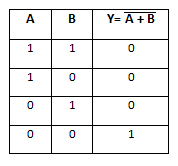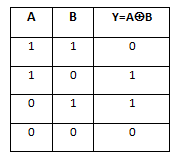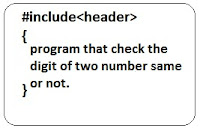 |
| logic gates |
LOGIC GATES:
Logical gates are the operator which connect two or more input signals
by checking logic between them and form a new signals.
Some basic logical gates are and the form which easy to understand.
1. Not gate
2. And gate
3. Or gate
4. Nand gate
5. Nor gate
6. Exclusive OR gate
7. Exclusive NOR gate
NOT
GATE:
Not gate also known as inverter. The function
of this gate is to invert the given value when we apply Not gate to a binary
value it invert that value. For instance we give 1 to Not gate it
convert into 0 and vice versa. We can give only one value at a time to
not gate.
Note: 1 means present of
current and, 0 means absent of current. And we take True as 1 and False
as 0.
Symbol of NOT gate:
 |
| not gate |
Ā= A not
Truth table for NOT gate:
 |
| truth table for not gate |
AND
GATE:
AND gate is a basic logic gate.
For understanding this operator let A and B are two binary values. The logic of
A and B denoted by A . B (A dot B), A . B is true when both A and
B are true otherwise false at any other conditions. For the result become
true all the given condition must be true.
Symbol of AND gate:
 |
| and gate |
Truth table for AND gate:
 |
| truth table for and gate |
OR
GATE:
OR gate is also a digital logic gate
which can operate in binary number such as A and B are two values. In OR gate
the result value became false when the given two are false other true at any
other condition.
Note: 1 means present of
current and, 0 means absent of current. And we take, True as 1 and False
as 0.
Symbol for OR gate:
 |
| or gate |
Truth table for OR gate:
 |
| truth table for or gate |
NAND
GATE:
NAND gate is actually the combination of and
gate and not gate. If we put NOT gate after AND gate then it will became NAND
gate. It inverts the AND gate result.
Symbol for NAND gate:
 |
| nand gate |
Truth table for NAND gate:
 |
| truth table for nand gate |
NOR
GATE:
It is actually the combination of
OR gate and not gate. If we put NOT gate after OR gate then it will became NOR
gate. It inverts the result of OR gate.
 |
| nor gate |
Truth table for NOR gate:
 |
| truth table for nor gate |
EXCLUSIVE
OR:
Let A and B are two values. The Exclusive
OR A and B are denoted by pÅq
is the Exclusive OR that is true when exactly one of the A and B is true and
false otherwise. It mean pÅq
is true if only one given value
is exactly true otherwise if both/all condition true then the result will be
false so only one condition should true.
Symbol for Exclusive OR gate:
 |
| exclusive or gate |
Truth table for Exclusive OR
gate:
 |
| truth table for exclusive or gate |
EXCLUSIVE
NOR GATE:
It also is the combination of
Exclusive OR gate and not gate. If we put NOT gate after Exclusive OR gate then
it will became NOR gate. It inverts the result of Exclusive OR gate. Means the
result will true if the both inputs have same value.
Symbol for Exclusive NOR gate:
 |
| exclusive nor gate |
 |
| truth table for exclusive nor gate |














